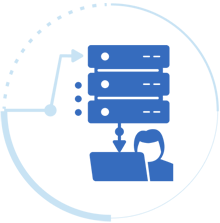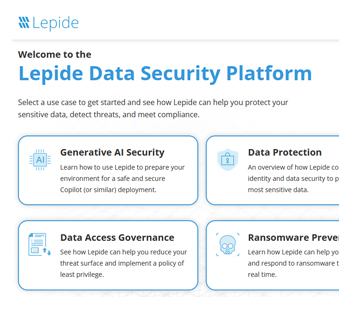Last Updated on February 17, 2025 by Deepanshu Sharma

Today’s hyperscale, data-driven digital world is causing businesses to produce, collect, exchange, and process an unprecedented amount of private and sensitive data. Data classification is an essential strategy in this context, as it enables businesses to efficiently organize, secure, and utilize data.
Recent studies indicate that over 402.74 million terabytes of data are created daily. Data classification serves as the foundation for compliance standards. Together, we will learn about data classification, its advantages, and its effects on the organization’s compliance standards.
What is Data Classification?
Data categorization is the process of putting data into groups that will be protected against theft, misuse, and compromise by a given degree of internal controls. Data classification enables businesses to describe the types, levels of sensitivity, and significance of the data that it has. Classification of data is an essential part of audit and compliance activities in both the public and private places.
In accordance with contractual, legal, and regulatory duties, the primary goal of data classification is to regulate the classification, use, disclosure, and security of the company’s data and data subjects.
In accordance with contractual, legal, and regulatory duties, the primary goal of data classification is to regulate the classification, use, disclosure, and security of the company’s data and data subjects.

Why Data Classification is Essential
Understanding data classification is essential given the evolving nature of cyber threats nowadays. Data classification is essential for companies for the reasons listed below:
Security
Data classification gives you the ability to make informed judgments about how to safeguard data against internal and external threats. You can’t use all your security resources to safeguard every bit of information. It is easier to determine the range of controls required to make data sets safe when they are grouped into one of the four classification levels. Rather than using a uniform approach to security measures, data classification helps identify regions that require more risk controls. Stronger security measures can be implemented where they are most needed by enterprises by identifying the most sensitive data. For instance, protecting sensitive data (such as restricted or confidential information) takes a large portion of your resources.
Compliance
65% of the world’s population will have their personal information covered by contemporary privacy laws, According to research. Because of this, ensuring the availability, security, and integrity of the organization’s data is more crucial than ever. There are currently about 80 counties with data privacy legislation in place. Even the US is moving closer to establishing a national standard for data protection with the June 2022 submission of a draft of the American Data Privacy and Protection Act (ADPPA) by a bipartisan committee.
Data categorization ensures that sensitive, regulated information continues to comply with all applicable privacy laws, rules, and regulations. Complying with regulations like GDPR, HIPAA, and PCI DSS requires an understanding of the location and security safeguards of sensitive data.
Efficiency
By ensuring that resources are used prudently, data classification enables more efficient data management. Classifying information facilitates decision-making and streamlines procedures by making files easier to locate. Solutions for automated data classification simplify data administration and security, freeing up employees’ time for valuable tasks.
Risk Reduction
The process by which companies recognize, evaluate, and manage risks that could jeopardize their resources and profits is known as risk management. Having complete control over all of the data that a business gathers, saves, and sends is a crucial component of a risk management program. The majority of enterprise-level firms handle large amounts of various kinds of data. Depending on the value, sensitivity, and risk to the organization of data loss, theft, or exposure, data classification enables you to offer the appropriate degree of security.
A Quote By David Gonzalez, Head of Big Data and Advanced Analytics- Vodafone Business.
Data is even more pervasive throughout the organization, while regulation on its use is becoming tighter. Consumers are far more aware of their privacy rights, and there is a clear directive on the ethical and appropriate ways to manage this. It’s never been more important to use data in a way that still protects the privacy of EU citizens. Achieving this requires that compliance is integral to the approach from the beginning – not as an afterthought. This is the only way to have peace of mind that the data you are using will reap reward, not risk.”
Why Data Classification is the Foundation of Compliance
Data classification is necessary to attain, maintain, and confirm compliance with a number of regulations and standards. Data categorization compliance regulations are acknowledged as the foundation of many industry- and region-specific laws and standards. These regulations are designed to ensure that companies handle data in a way that safeguards security, privacy, and ethical use.
By following these guidelines, the business can protect sensitive data and avoid data breaches, legal problems, and heavy fines. For example, whereas PCI DSS, HIPAA, SOX, and GDPR all have different objectives and specifications, data classification is necessary to meet them all. After all, you need to precisely identify and tag financial papers, cardholder information, medical records, and other regulated data in order to preserve it.
How Does Data Classification Help Businesses?
Data Classification is an essential step for assessing risks at your organization and creating a comprehensive information security strategy. Below are a few steps on how data classification helps businesses:
- Data Access Control: Data classification makes data administration easier for any firm. Businesses may swiftly set up access permissions and limits based on the sensitivity of the data by giving it appropriate classification labels. This setup reduces data access bottlenecks and expedites decision-making in hectic business environments where speed and efficiency are crucial. Additionally, a well-structured classification system allows companies more flexibility with less critical data while maintaining stricter restrictions over sensitive data, which aids in risk management. This tiered access architecture increases operational efficiency while maintaining security.
- Data Discovery and Retrieval: Effective classification of data is crucial for improving information discoverability and retrievability, as well as aiding in information security. With a clear classification system, employees can locate and retrieve data quickly and effortlessly. Whether it is for customer service to access current data or for regulatory purposes to retrieve historical data, classification systems make it easier to arrange data logically and intuitively. Utilizing metadata management techniques, which classify and index data using metadata tags, also facilitates faster data discovery and retrieval. Reducing the amount of time spent searching through massive databases for information will increase productivity and decrease team member annoyance.
- Cost-Efficient Storage: Lastly, effective data classification immediately reduces IT and data administration costs. By classifying data storage and protection solutions according to categorization levels, businesses can concentrate on high-security measures for critical data and cost-effective storage for non-sensitive information. This leads to a more economical approach to data management since it optimizes resource allocation across departments and reduces the overall cost of data storage. Furthermore, a simplified data handling process eliminates the need for extensive manual labor and oversight, resulting in lower labor costs and more IT resources available for other strategic initiatives. Thus, this improved technique aids in more thorough, economical business
How to Develop a Good Data Classification Model
The term “data classification model” describes the framework that IT-based systems use to group data into distinct categories to improve data security and protection. This model gives businesses a uniform template for illustrating the proper way to classify, identify, and organize data. Because of the complexity of the data, its quality, privacy and regulatory restrictions, and many other issues, developing an efficient data classification model can be difficult. To create a good data classification model, follow these steps:
- Define Clear Objectives: Ascertain that the organization’s contractual and regulatory privacy requirements are understood. The goals of data classification should be well-defined through an interview-based process involving important stakeholders, such as compliance, and legal business unit leaders. A clear evaluation of the type and nature of the data is also necessary. Certain models do best with particular kinds of data. It is simple to create the categorization model once the goals are well-defined.
- Develop a Classification Policy: Policies and procedures must be clear, well-developed, sensitive to particular forms of data, and simple for staff to understand. Three or four data classification categories must exist for them to be deemed realistic. The sort of data included, data guidelines, and potential breach concerns should all be covered in detail in each area. To show regulatory relevance or other access control models that could be needed, it might be worthwhile to divide the top (most sensitive) category into smaller groups. For instance, the following subcategories can be added – PCI (Cardholder) data, HIPAA- relevant, GDPR-relevant. Following the completion and dissemination of a policy, end users should categorize all freshly created and recently evaluated data going ahead before focusing on legacy data that is at rest.
- Categorizing Data: Identifying the types of sensitive data that are present in the organization based on sensitivity levels is essential for creating an effective classification model. It’s an endeavor that needs to be led by process owners and structured around business processes. Every company operation should be taken into consideration; monitoring the data flow gives you insight into what information has to be safeguarded and how. For an organization to properly classify its data, it must be aware of what it has. Identification of data types, locations, owners, and access points are all part of this procedure. A few questions include: What data is created, what data is collected and developed, what data is confidential, and what data does your company collect about its customers and partners?
- Discover Data Location: Once your organization’s data kinds have been determined, it’s critical to list all of the locations where data is kept electronically. One important factor is the movement of data into and out of the company. In what ways does your company exchange and store information both internally and externally? Are cloud-based services like Dropbox, Box, OneDrive, and others something you use? Regardless of the format or location of your company’s data storage, data discovery solutions can help you create an inventory of unstructured data and pinpoint its exact location. By offering details on who is processing data, these technologies also assist in resolving issues with data owner identification. Add particular data formats or types, such credit card numbers, social security numbers, or medical record numbers, to the search.
- Classification Tools: The speed and accuracy of data classification can be significantly increased by using automated data classification tools whenever feasible. By making it easier to identify suitable classes and then apply the classification label to the item’s metadata or as a watermark, commercial classification tools assist data classification campaigns. Knowing where your data is kept will help you identify it and categorize it for proper protection. Think about the consequences of a loss or violation. For instance, if protected health information is compromised by a HIPAA breach, what penalties may be assessed per record? Knowing how much it could cost to compromise a data set will help you determine how much it will cost to safeguard it and what classification level to use.
- Measures and Controls: To guarantee that the right solutions are in place, establish baseline cybersecurity protections, and provide policy-based restrictions for every data classification label. More sophisticated layers of protection are needed for high-risk data and less for low-risk data. Understanding the location of data and its organizational significance will help you apply the right security policies based on the risks involved. Encryption, data loss prevention (DLP), and other security systems can employ classification metadata to identify sensitive information and define the appropriate security measures.
- Review and Update: It is important to regularly evaluate data to make sure the classification policy is being followed. Changes in the business environment, new data types, and legal needs should all be taken into consideration while updating and monitoring the process. Be ready to keep an eye on and maintain the data classification system used by the company. Classification rules ought to be flexible. Establishing a review and update procedure that engages users is necessary to promote adoption and guarantee that your strategy keeps up with the evolving demands of the company.
Is Data Classification Required in PII Protection?
Personal Identifiable Information (PII) is any data or information that, if revealed, may be used to track down or uniquely identify a person. The identified person may sustain loss or experience other adverse outcomes if sensitive PII data is disclosed. Personal information includes things like name, birthdate, address, credit card number, health insurance information, and many more.
PII is separated into two groups:
1. Sensitive PII: Financial records, health information, social security numbers, and biometric information are all included in this. Under compliance frameworks, sensitive PII frequently needs the highest levels of protection due to its important nature. These measures include encryption, restricted access, and thorough auditing procedures.
2. Non-Sensitive PII: Information that is less important alone, such as names, phone numbers, or email addresses, might become sensitive when paired with other information. Protection measures for aggregated datasets are frequently required by compliance frameworks in order to reduce the risks of re-identification and unauthorized access.
Getting PII-appropriate data classification is necessary for effective data protection. Below are a few reasons why data classification is required in PII protection:
1.Preventing Data Breaches: Once PII has been identified and classified, organizations can put targeted security measures in place to secure sensitive data. The likelihood of data breaches, which can have serious financial and reputational consequences, is decreased as a result. For instance, limiting access or encrypting extremely sensitive PII can help you to prevent data breaches.
2.Enhancing Data Management: Data management procedures are streamlined by classification, which makes it simpler to find and handle PII based on its classification level. Better data governance and cleanliness are supported by this efficiency, which strengthens the security posture overall.
3.Compliance Requirements: A number of laws, like the California Consumer Privacy Act (CCPA) in the US and the General Data Protection Regulation (GDPR) in Europe, require that PII be handled and protected with extreme care. An organization can comply with these regulatory obligations and prevent fines and penalties by maintaining accurate classification.
How Do Compliance Standards Impact Data Classification?
Data categorization rules must be implemented by businesses in accordance with a variety of regulatory frameworks and industry-specific standards. Adhering to data security and privacy regulations provides various common standards and their data classification requirements::
- HIPAA: Personal health information, or PHI, is regarded as a high-risk asset. Covered organizations and pertinent business associates must identify PHI and put in place measures to guarantee its confidentiality, availability, and integrity in accordance with the HIPAA security rule. PHI uses and disclosures are restricted by the HIPAA rule, which also requires covered companies and business associates to set up data classification protocols.
- SOC 2: Security, Availability, Confidentiality, Processing Integrity, and Privacy are the Trust Services Criteria that must be met to secure customer data that an organization processes and maintains as part of the services it offers. Entities must show that they consistently identify and preserve sensitive data in a way that satisfies their particular confidentiality goals to pass the Trust Services Criteria of SOC 2.
- GDPR: Classification of all acquired data kinds is mandatory for companies that handle the personal data of European data subjects. According to GDPR, certain information about ethnicity, political beliefs, health, ethnic origin, and biometrics is deemed “special.” This data needs to be protected further. One crucial due diligence process that facilitates the identification of personal data and the necessary Data Protection Impact Assessment (DPIA) is data classification.
- PCI-DSS: Meeting PCI-related regulations requires determining how sensitive specific data items are to secure cardholder data. To establish the sensitivity of the data, this rule requires that the entities classify the data.
How Lepide Helps
Lepide Data Security Platform makes it easier to find and categorize different kinds of data stored across on-premises servers and cloud-based servers. By using proximity scanning, Lepide finds patterns that provide context, guaranteeing precise predictions of sensitive data and preventing false positives. Reports and notifications on how users interact with sensitive or regulated data can be generated, and Lepide can also automatically detect and react to risky user activity in real-time.
Additionally, Lepide makes it simple to identify critical data breaches, such as GDPR-compromised access to medical records. The program provides a vast library of pre-established criterion sets for different kinds of sensitive data and compliance standards. This ensures compliance with laws like HIPAA, SOX, PCI, GDPR, and CCPA by making it simple to identify and safeguard sensitive data.
Want to see how Lepide helps to simplify data classification in your environment? Download the free trial or schedule a demo with one of our engineers today!


 Group Policy Examples and Settings for Effective Administration
Group Policy Examples and Settings for Effective Administration 15 Most Common Types of Cyber Attack and How to Prevent Them
15 Most Common Types of Cyber Attack and How to Prevent Them Why AD Account Keeps Getting Locked Out Frequently and How to Resolve It
Why AD Account Keeps Getting Locked Out Frequently and How to Resolve It
